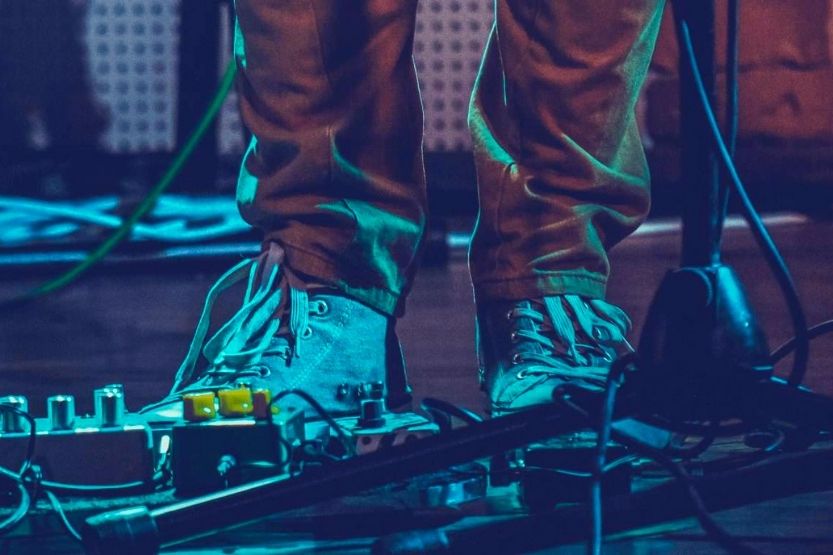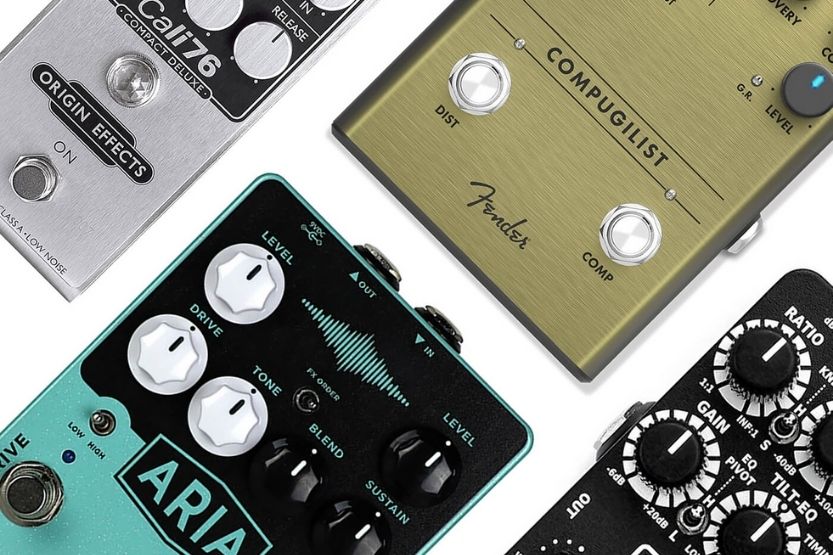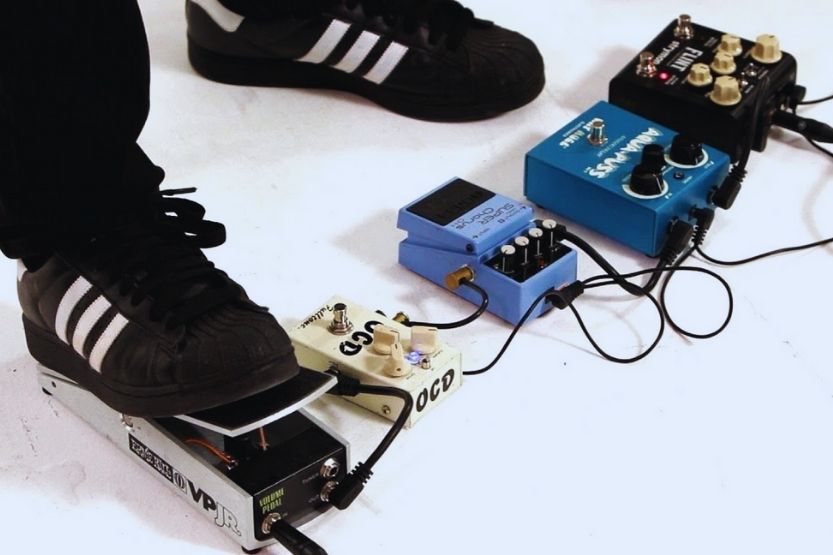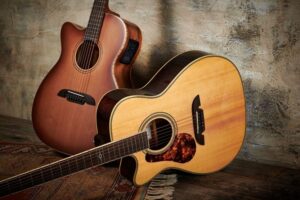From distortion to overdrive, guitar pedals are available in different types, each with its respective functions. Among others, a compressor pedal is one of the most popular. What does a compressor pedal do?
A compressor pedal evens out and balances the dynamics in music. It is a common guitar accessory that makes softer tones more audible and louder notes more subtle. It has different controls with various functions, such as sustain, attack, recovery, and blend.
Here is a quick list of what a compressor pedal can do:
- Squashes the dynamics
- Boosts a subtle tone
- Increases sustain
- Enhances funk
- Improves muddy pickup
Read on to learn more about the functions of a compressor pedal and understand how it can make a significant difference.
What Is a Compressor Pedal?

To fully understand the definition of a compressor pedal, you must know what compression is. The latter is a recording concept that controls an audio signal’s overall level and dynamics. In sound engineering, compression makes the louder parts quieter and the quiet parts more apparent. The result is that it balances sound.
In a simpler sense, you can see compression as an automatic volume control. It turns the signal up or down depending on other conditions. Additionally, it narrows the dynamic range and makes the volume more consistent.
A compressor pedal is what will make the compression possible. It is a signal chain stompbox that changes a guitar’s dynamics. A compressor is an old technology that is used even in telephones and radio broadcasting. For instance, when people are clapping in the background, compression makes it quieter not to overwhelm a speaker.
What Does a Compressor Pedal Do?
In a nutshell, we have already given you an idea of what a compressor pedal does – it balances the overall tone to improve the sound. It might be too broad so that the next discussions will talk about the specific functions of a compressor pedal:
1. Squashes the Dynamic Range
As mentioned earlier, the most common use of a compressor pedal is to compress or squash the dynamic range. Especially when you are playing an acoustic guitar, the volume range can have a wide difference. This will depend on how your fingers are attacking the strings. The pressure that you exert can affect the volume.
Many songs will have a gentle portion, which means that you will be putting less pressure on the strings. Such will create a more mellow sound, but the volume can suffer. Such is when the compressor pedal works by making the sound more audible.
On the other hand, when you strum too hard, the volume will peak. With a compressor pedal, the guitar will have lower peak frequencies to even out the sound. As a result, it is more dynamic and balanced, which will be pleasant to the ears.
2. Boosts a Subtle Tone
The concept is similar to how a compressor pedal squashes dynamic range. For instance, imagine that you are playing in a band. The drums are too loud, which can overpower the guitar. To avoid getting buried by the band, you can use a compressor pedal. In turn, it amplifies the original signal to make your tone more evident.
Even when you are playing solo, a compressor pedal will make subtle tones more audible. It can slightly increase the volume as necessary. While an amplifier can do the same thing, a compressor pedal does a better job for guitars.
3. Increases Sustain
Increasing guitar sustain is possible by doing several things, such as:
- Cleaning your instrument,
- Adjusting the pickup height,
- Customizing the tuners,
- Changing the frets, and
- Tweaking the bridge.
Another simple but effective solution is the use of a compressor pedal. It is especially true in an electric guitar. Meanwhile, in an acoustic guitar, it is natural to have minimal sustain.
If you engage the compressor pedal when playing an electric guitar, you can expect that the notes will be more evident longer. Rather than thinking about perfectly hitting every note, you can shift your focus on playing better.
4. Enhances Funk
Being treble-focused, a guitar boasts high-end sound and funk lines. While it can do so by itself, it is better to have a helping hand in the form of a compressor pedal.
Funk is a music genre that relies heavily on dynamic changes. This means there is a need to even out certain parts of the song, making compression a must.
With a compressor pedal, you will be in complete control of the tone. More so, it can make the note thicker, adding a funky beat to the music.
5. Improves Muddy Pickup
When you raise a neck pickup when playing guitar, it becomes darker and louder. While it is initially harmonically rich, it soon becomes muddy. When it reaches a point that it is too close to the strings, you will notice no more dynamic range left. All that you can hear is a thick and loud sound. Such is another instance when a compressor pedal comes in handy.
A compressor pedal lifts and boosts the buried frequencies. This means that increasing the fullness and volume will not overwhelm the sound.
Types of Compressor Pedals

Now that you know what a compressor pedal does, you are probably convinced that you need one. If that is the case, below is a quick rundown of the different types of compressor pedals available in the market:
1. Voltage Controlled Amplifier (VCA)
Also known as VCA, this is the most popular of all compressor pedals. It does not color or distort the sound from the guitar. Meaning, it can work well with other pedals while ensuring high-quality output. It has an IC chip with transistors to follow incoming voltage. As a result, it has clean and fast compression.
2. Field Effect Transistor
The FET compressor pedal is often seen as a part of the VCA. Nonetheless, it has its characteristics. It has a special transistor that changes the gain. It works like a vacuum tube in a circuit and is quite similar to an analog amp. Additionally, the compressor is known for being fast.
3. Operational Transconductance Amplifier
Like the VCA, it is also a chip with a variable current. The name is a reference to the design of the pedal’s circuit. It is also the basis of the construction of many boutique compressor pedals that you will find in the market.
4. Optical Compressor
This type of compressor has a LED or light source that monitors the input. The brighter the light is, the louder the signal gets. It has a slower response compared to the other compressor pedals. Nonetheless, many people love it because it sounds natural.
5. Tube Compressor
The last on this list is a tube compressor or also known as variable mu. Instead of a transistor, it relies on a vacuum tube. Also, the bias of the tube changes depending on the variable voltage input. Its action is slightly different from most of its competitors, resulting in a smoother and more organic sound.
Again, what does a compressor pedal do? A guitarist’s compressor pedal is a stompbox pedal located in their signal chain. This pedal balances out their guitar performance’s dynamics. Meaning, when you strike a string too hard, the compressor will smoothen the sound.
Compressor Pedal Controls
When looking for the best compressor pedals, the controls are amongst the most critical considerations. They will vary from one model to another, with the most option being those I will discuss below:
1. Sustain or Compression
The most important control is the pedal signal’s compression level. To get a higher sustain, choose one that comes with a higher dial. However, note that the signal can have more noise when there is higher compression.
2. Attack
It controls the effect of the compression on an input signal. Turn the knob up if you want the hard pluck in a pick stroke to be more audible. If you want the sound to be more natural, then you should go for a slower attack.
3. Release or Recovery
It dictates the duration of bouncing back to the normal of the compressed note. The adjustment of this control is almost similar to what you would do with the control for an attack.
4. Ratio
Also called limiting, it dictates how much the volume will lower once the compressor starts functioning. With a higher ratio, expect that there is a higher compression above the threshold.
5. Tone
Among the controls on this list, this is the one with the least impact on the compression. Nonetheless, it is worth mentioning that it is responsible for equalizing the music after its compression.
6. Blend
It gives you more freedom for mix adjustment. You can balance the compressed signal with the dry and uncompressed signal. This knob is often dealt with after determining the level of sustain and speed of the attack.
7. Multiband
A common control that you will find in high-end models allows independent processing of various frequencies.
Tips and Tricks When Using a Compressor Pedal

Before I conclude this guide, allow me to share with you some tips on how you can make the most of a compressor pedal:
1. Avoid Using Too Much Compression
Avoid using too much compression or taking it too far. The abuse of this tool can squeeze volume, which affects the overall quality of the recording or playback. It is crucial to have the perfect balance between loud and soft parts.
2. Know When to Engage the Compressor Pedal
Know when to engage the compressor pedal. One of the best situations would be during the lead lines. This way, it increases sustain to make the sound of the guitar more apparent. It is especially effective during a guitar solo.
3. Experiment With the Controls
Practice and experiment with the controls. Often, it is trial and error. Take the time to figure out how the controls work, and more importantly, how they affect the audio output.
4. Choose the Right Compressor Pedal
Choose the right compressor pedal. Read reviews and learn from the real-life experiences of other users. I would personally go beyond price. Quality and performance are more important considerations, even if they make a product more expensive.
Conclusion – What Does a Compressor Pedal Do
Whether you are playing an acoustic or electric guitar, the compressor pedal is one of the most important tools to have. It works by balancing the tones, making sure that none overpowers the other. For instance, it makes the louder portions of audio softer and the quieter parts more audible, changing the overall dynamics.
As noted above, using a compressor pedal helps in doing the following:
- Squashing the dynamics
- Boosting a subtle tone
- Increasing sustain
- Enhancing funk
- Improving muddy pickup
To deliver its various functions, you can control a compressor pedal through its controls or knobs. It has control for sustain, attack, recovery, level, and blend, among others. The overall quality of the sound will change depending on which part of the pedal you are adjusting.
Related reading:
What Is the Difference Between Acoustic and Electric Guitar Strings?
What Are The Differences Between Four and Five String Bass Guitars?
What Are the Differences Between a Bass Amp and a Guitar Amp?



